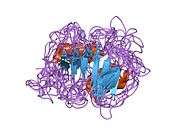CCL7
| View/Edit Human | View/Edit Mouse |
Chemokine (C-C motif) ligand 7 (CCL7) is a small cytokine known as a chemokine that was previously called monocyte-chemotactic protein 3 (MCP3). Due to CCL7 possessing two adjacent N-terminal cysteine residues in its mature protein, it is classified among the subfamily of chemokines known as CC chemokines. CCL7 specifically attracts monocytes, and regulates macrophage function . It is produced by certain tumor cell lines and by macrophages.[3] This chemokine is located on chromosome 17 in humans, in a large cluster containing many other CC chemokines[4] and is most closely related to CCL2 (previously called MCP1).
Interactions
CCL7 has been shown to interact with MMP2.[5]
References
- ↑ "Human PubMed Reference:".
- ↑ "Mouse PubMed Reference:".
- ↑ Opdenakker G, Froyen G, Fiten P, Proost P, Van Damme J (1993). "Human monocyte chemotactic protein-3 (MCP-3): molecular cloning of the cDNA and comparison with other chemokines". Biochem. Biophys. Res. Commun. 191 (2): 535–42. doi:10.1006/bbrc.1993.1251. PMID 8461011.
- ↑ Opdenakker G, Fiten P, Nys G, Froyen G, Van Roy N, Speleman F, Laureys G, Van Damme J (1994). "The human MCP-3 gene (SCYA7): cloning, sequence analysis, and assignment to the C-C chemokine gene cluster on chromosome 17q11.2-q12". Genomics. 21 (2): 403–8. doi:10.1006/geno.1994.1283. PMID 7916328.
- ↑ McQuibban, G A; Gong J H; Tam E M; McCulloch C A; Clark-Lewis I; Overall C M (August 2000). "Inflammation dampened by gelatinase A cleavage of monocyte chemoattractant protein-3". Science. UNITED STATES. 289 (5482): 1202–6. doi:10.1126/science.289.5482.1202. ISSN 0036-8075. PMID 10947989.
Further reading
- Menten P, Wuyts A, Van Damme J (2002). "Monocyte chemotactic protein-3.". Eur. Cytokine Netw. 12 (4): 554–60. PMID 11781181.
- Van Damme J, Proost P, Lenaerts JP, Opdenakker G (1992). "Structural and functional identification of two human, tumor-derived monocyte chemotactic proteins (MCP-2 and MCP-3) belonging to the chemokine family.". J. Exp. Med. 176 (1): 59–65. doi:10.1084/jem.176.1.59. PMC 2119277
 . PMID 1613466.
. PMID 1613466. - Ben-Baruch A, Xu L, Young PR, et al. (1995). "Monocyte chemotactic protein-3 (MCP3) interacts with multiple leukocyte receptors. C-C CKR1, a receptor for macrophage inflammatory protein-1 alpha/Rantes, is also a functional receptor for MCP3.". J. Biol. Chem. 270 (38): 22123–8. doi:10.1074/jbc.270.38.22123. PMID 7545673.
- Opdenakker G, Fiten P, Nys G, et al. (1994). "The human MCP-3 gene (SCYA7): cloning, sequence analysis, and assignment to the C-C chemokine gene cluster on chromosome 17q11.2-q12.". Genomics. 21 (2): 403–8. doi:10.1006/geno.1994.1283. PMID 7916328.
- Minty A, Chalon P, Guillemot JC, et al. (1993). "Molecular cloning of the MCP-3 chemokine gene and regulation of its expression.". Eur. Cytokine Netw. 4 (2): 99–110. PMID 8318676.
- Opdenakker G, Froyen G, Fiten P, et al. (1993). "Human monocyte chemotactic protein-3 (MCP-3): molecular cloning of the cDNA and comparison with other chemokines.". Biochem. Biophys. Res. Commun. 191 (2): 535–42. doi:10.1006/bbrc.1993.1251. PMID 8461011.
- Combadiere C, Ahuja SK, Van Damme J, et al. (1996). "Monocyte chemoattractant protein-3 is a functional ligand for CC chemokine receptors 1 and 2B.". J. Biol. Chem. 270 (50): 29671–5. doi:10.1074/jbc.270.50.29671. PMID 8530354.
- Power CA, Clemetson JM, Clemetson KJ, Wells TN (1996). "Chemokine and chemokine receptor mRNA expression in human platelets.". Cytokine. 7 (6): 479–82. doi:10.1006/cyto.1995.0065. PMID 8580362.
- Daugherty BL, Siciliano SJ, DeMartino JA, et al. (1996). "Cloning, expression, and characterization of the human eosinophil eotaxin receptor.". J. Exp. Med. 183 (5): 2349–54. doi:10.1084/jem.183.5.2349. PMC 2192548
 . PMID 8642344.
. PMID 8642344. - Kim KS, Rajarathnam K, Clark-Lewis I, Sykes BD (1996). "Structural characterization of a monomeric chemokine: monocyte chemoattractant protein-3.". FEBS Lett. 395 (2-3): 277–82. doi:10.1016/0014-5793(96)01024-1. PMID 8898111.
- Meunier S, Bernassau JM, Guillemot JC, et al. (1997). "Determination of the three-dimensional structure of CC chemokine monocyte chemoattractant protein 3 by 1H two-dimensional NMR spectroscopy.". Biochemistry. 36 (15): 4412–22. doi:10.1021/bi9627929. PMID 9109648.
- Polentarutti N, Introna M, Sozzani S, et al. (1997). "Expression of monocyte chemotactic protein-3 in human monocytes and endothelial cells.". Eur. Cytokine Netw. 8 (3): 271–4. PMID 9346360.
- Bonini JA, Martin SK, Dralyuk F, et al. (1997). "Cloning, expression, and chromosomal mapping of a novel human CC-chemokine receptor (CCR10) that displays high-affinity binding for MCP-1 and MCP-3.". DNA Cell Biol. 16 (10): 1249–56. doi:10.1089/dna.1997.16.1249. PMID 9364936.
- Nibbs RJ, Wylie SM, Yang J, et al. (1998). "Cloning and characterization of a novel promiscuous human beta-chemokine receptor D6.". J. Biol. Chem. 272 (51): 32078–83. doi:10.1074/jbc.272.51.32078. PMID 9405404.
- Wang JM, Ueda H, Howard OM, et al. (1998). "HIV-1 envelope gp120 inhibits the monocyte response to chemokines through CD4 signal-dependent chemokine receptor down-regulation.". J. Immunol. 161 (8): 4309–17. PMID 9780207.
- Albini A, Ferrini S, Benelli R, et al. (1998). "HIV-1 Tat protein mimicry of chemokines.". Proc. Natl. Acad. Sci. U.S.A. 95 (22): 13153–8. doi:10.1073/pnas.95.22.13153. PMC 23742
 . PMID 9789057.
. PMID 9789057. - Rabin RL, Park MK, Liao F, et al. (1999). "Chemokine receptor responses on T cells are achieved through regulation of both receptor expression and signaling.". J. Immunol. 162 (7): 3840–50. PMID 10201901.
- Wedemeyer J, Lorentz A, Göke M, et al. (1999). "Enhanced production of monocyte chemotactic protein 3 in inflammatory bowel disease mucosa.". Gut. 44 (5): 629–35. doi:10.1136/gut.44.5.629. PMC 1727483
 . PMID 10205198.
. PMID 10205198. - Blanpain C, Migeotte I, Lee B, et al. (1999). "CCR5 binds multiple CC-chemokines: MCP-3 acts as a natural antagonist.". Blood. 94 (6): 1899–905. PMID 10477718.
- Jordan NJ, Kolios G, Abbot SE, et al. (1999). "Expression of functional CXCR4 chemokine receptors on human colonic epithelial cells.". J. Clin. Invest. 104 (8): 1061–9. doi:10.1172/JCI6685. PMC 408573
 . PMID 10525044.
. PMID 10525044.
This article is issued from Wikipedia - version of the 7/20/2016. The text is available under the Creative Commons Attribution/Share Alike but additional terms may apply for the media files.



